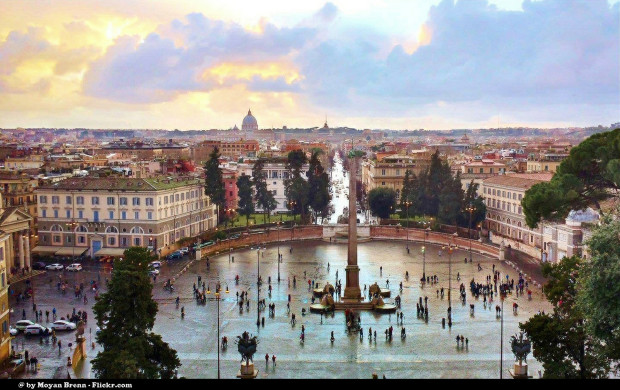Photo Credit: “Rome” by Moyan Brenn.
Don’t be fooled by the crumbling ruins, Baroque churches and the nagging feeling you’ve stumbled onto a movie set. Rome may be packed with millennia of history, but this is a vibrant, living city—not a museum. Yes, that’s the alley Audrey Hepburn and Gregory Peck sped down on a Vespa in “Roman Holiday,” but not far away, modern-day Romans are opening up funky fashion boutiques, trendy bars and ambitious new restaurants. Here’s what you need to know when travelling to Rome.
1. About Rome’s two airport options
Rome has two airports, so before planning transportation to your hotel or first destination, be sure to identify which you’ll be flying into. Leonardo da Vinci – Fiumicino Airport tends to service more regular flights from more expensive airlines, while more low-cost carriers typically fly to Ciampino – G. B. Pastine International Airport. Fiumicino also has the more enviable shopping and dining options. After a long night flight, grab an espresso and a pastry for breakfast at Rustichelli & Mangione for a pick-me-up. But there’s not a lot worth lingering around for at Ciampino.
The Leonardo Express whisks passengers from Fiumicino to Termini Station in roughly half an hour for €14, and Ciampino is connected to the city by bus.
2. Technology needs
The standard voltage rate in Italy is 230 volts, 50 Hz, or nearly double that of the US, Canada, Japan and many South American countries. While laptops and some other battery-powered electronics will automatically adjust to the difference, pack a step-down transformer to stay on the safe side, as well as a Type C European socket adaptor. Travellers from the UK should be able to get by with just a socket adaptor, while those from the rest of Europe and many Asian countries will not need to bring anything extra at all.
Some businesses offer complimentary Wi-Fi, but there’s no guarantee when you’ll stumble upon one. Alternately, the nonprofit RomaWireless makes Wi-Fi available in several public hot spots around the city at no charge for up to two hours per day. Travellers hoping to stay connected throughout their trip may want to rent portable hot spots from places like Wi Tourist or ExpressoWiFi.
3. Getting around Rome
Buses provide a practical means of getting around Rome. Always buy bus tickets before boarding at a tobacco stand or kiosk. Better yet, use BIPiù, a mobile payment system, to buy and use all of your public travel passes with your smartphone. Rome’s public transit options are conveniently integrated into one system, making switching from one mode to the next seamless.
The Rome Metro is an efficient option, though you’ll miss sightseeing opportunities when below ground. On the other hand, the local traffic makes navigating cobblestoned streets by taxi a nuisance. To have a truly Italian experience—and a more convenient one—instead of renting a car, go for a Vespa that can squeeze into narrow parking spaces. Nervous about riding solo? Scooteroma organises Vespa and bicycle tours focusing on food, film, culture, street art and more.
4. Rome weather and what to pack
Rome is cool and green in the spring and fall, but can be scorching in the summer. While businesses offer relief from the unrelenting sun, few have central air conditioning. Especially if traversing historic areas such as the Roman Forum, which offers little shade, be sure to dress appropriately and bring a hat and sunblock. Tempting though it might be when temperatures climb, be wary of packing skimpy shorts and tank tops if you plan to visit the city’s historic churches. Places of worship here tend to enforce a dress code and request that visitors cover their shoulders and legs out of respect. Lightweight, modest clothes made from breathable fabrics such as cotton or linen are your safest bet.
No matter where you go, carry plenty of water to stay hydrated. While most locals prefer bottled water, the tap water is generally safe to drink. Families with small travellers in tow may want to help them cool off the old-fashioned way—with a cup of some of the most luscious ice cream anywhere. Il Gelato di San Crispino, with a branch just steps from the Pantheon, makes artisanal gelato with seasonal fruits and all-natural ingredients.
_________________________________________________________
RELATED: Top 10 Things to Know Before You Arrive In:
Amsterdam | Birmingham | Brussels | Edinburgh | Istanbul | London | Paris
5. Tip Rome-style
Although the common Italian restaurant cover charge known as coperto is banned in Rome, many restaurants will add a servizio, or service charge, to the bill. Tipping in restaurants beyond that is not required, but it is polite to leave a couple of extra euros.

Photo Credit: “Rome” by Moyan Brenn.
6. Staying secure
Violent crime is rare in Rome, but pickpockets can pose a serious problem and often target travellers. Pay close attention to your belongings in Termini Station, the metro and around tourist attractions such as St. Peter’s Basilica, the Pantheon and the Trevi Fountain. If possible, avoid carrying a conspicuous camera, and store currency in a concealed money belt.
7. Skip the queues
Taking in some of the world’s finest art is a key part of the Roman experience. That doesn’t mean you have to spend your whole trip waiting to catch a glimpse of the greats. Instead of braving the lines and paying a hefty admission fee at the Vatican Museums, see works by old masters at smaller churches around the city.
For example, you can view paintings by Caravaggio in San Luigi dei Francesi, statues by Michelangelo in Santa Maria Sopra Minerva, and frescoes by Raphael in the Villa Farnesina.
8. Explore beyond the Historic centre
Captivating as the most famous Roman sights may be, the city has even more wonders to offer the culturally curious traveller. Set aside at least an afternoon to explore the district of Tor Marancia, which is in the midst of a revival thanks to an influx of creatives and street art. The incredible, building-sized murals are reason enough to make the jaunt.
Closer to the centre, the once-gritty neighbourhoods of Testaccio and Trastevere have become bustling havens for young locals with terrific nightlife and restaurants. The former features impressive street murals of its own, while the latter has become a hotbed of culinary activity. In Trastevere, travellers can sample everything from Michelin star cuisine at Glass Hostaria to refined Roman fare at Osteria Fernanda to rustic dishes at Da Enzo, a traditional hole-in-the-wall with charm to spare.

Photo Credit: “When In Rome…” by Bert Kaufmann.
9. Eat like a Roman
When you’re travelling to a country revered for its food, you don’t want to waste a single meal on subpar restaurants or tourist traps. For an authentic experience, visit Rome’s farmers’ markets, which can be found in various locations, including the famed Campo de’ Fiori square and the historic Mercato Trionfale. Situated near the Tiber River, the indoor Nuovo Mercato di Testaccio hosts dozens of vendors selling everything from braised tripe sandwiches at Mordi & Vai to Sicilian cannoli at Dess’Art.
Food near tourist attractions is sometimes of dubious quality, but many trattorias off the main drag still serve soulful home cooking for reasonable prices. To try a seasonal local delicacy, order olive oil-fried carciofi alla giudìa (Jewish-style artichokes) at Ba’ghetto or one of the many other eateries in the former Jewish ghetto.
10. Stick to Italian time
Slow down. In Rome, meals tend to start and run later than in the US or northern Europe, meaning lunch often begins around 2:00 p.m. and many locals eat dinner at 10:00 p.m. Also, be aware that most shops shut down on Sundays and during the week in the afternoon for an hour or two. If travelling with children, be sure to load up on portable snacks to stave off temper tantrums between meals.





